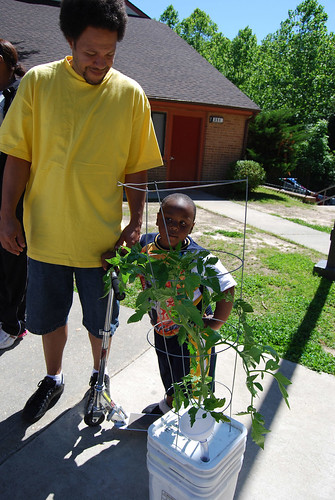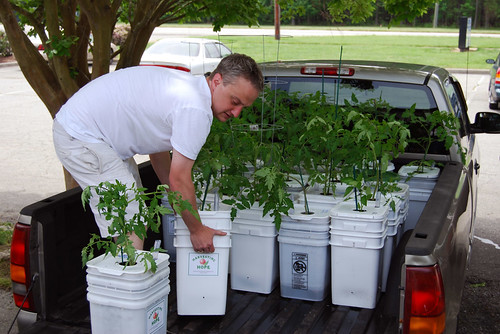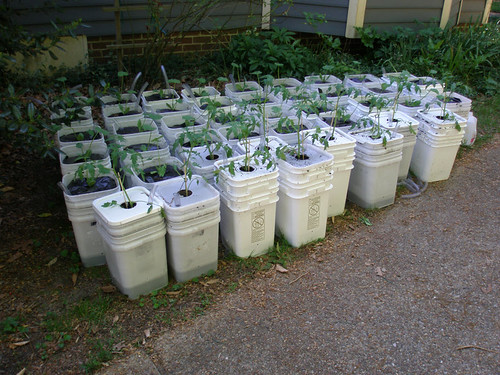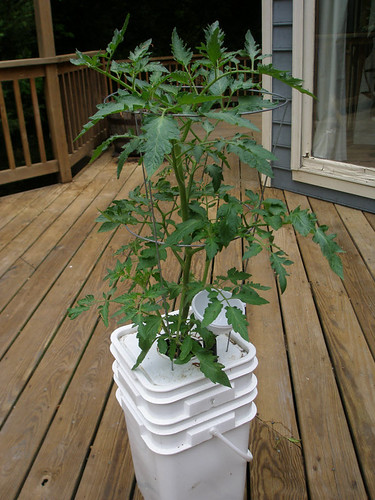
Harvesting Hope is setting first-time gardeners up for success: our container gardens require much less frequent watering than conventional flower pots and no additional fertilization. We’re filling the containers with high-quality, nutrient-rich organic potting soil and disease-resistant varieties of popular vegetables, including tomatoes, zucchini, peppers, cucumbers, and Japanese eggplant.
How it works.A conventional flower pot is watered from the top and has one or more holes in the bottom through which excess water can escape. Between waterings, the soil becomes progressively drier as the plant and the sun draw water out of the pot. When the soil is oversaturated (due to overwatering or during a rainstorm) excess water drains out of the bottom of the pot and carries rinsed soil nutrients along with it.
A Harvesting Hope container garden is essentially a closed system. Instead of pouring water into the pot from above, the gardener fills a reservoir beneath the soil through a fill pipe and funnel.
 A perforated, earth-filled plastic cup extends into the reservoir and the drier soil above it draws moisture upward by capillary action. (The same principle can be observed by submerging a shirtsleeve in a water-filled sink while placing the rest of the shirt on the adjacent dry countertop. After an hour or two, the entire shirt will be damp.)
A perforated, earth-filled plastic cup extends into the reservoir and the drier soil above it draws moisture upward by capillary action. (The same principle can be observed by submerging a shirtsleeve in a water-filled sink while placing the rest of the shirt on the adjacent dry countertop. After an hour or two, the entire shirt will be damp.)
- Between waterings, the soil remains uniformly damp as it wicks moisture up from the reservoir. The soil begins to dry out only after the reservoir has been depleted, giving the plant a consistently moist environment.
- Since the water source is beneath the plant, the system encourages roots to grow downward toward the reservoir (and eventually into it), permitting the plant to take maximum advantage of the space and nutrients it has available.
 The plant is watered from the top only during a rainstorm, and excess water can accumulate in the reservoir instead of draining out of the system. As a consequence, very little water can escape the container except through the plant or by limited evaporation, and soil nutrients can leave only through the plant.
The plant is watered from the top only during a rainstorm, and excess water can accumulate in the reservoir instead of draining out of the system. As a consequence, very little water can escape the container except through the plant or by limited evaporation, and soil nutrients can leave only through the plant.
 How It's Built
How It's Built
Each container garden consists of the following parts:
- Two matching five-gallon plastic buckets and one lid
- A perforated, 9-ounce plastic Solo cup
- A 20-inch length of 3/4-inch plastic tubing
- A plastic funnel
- Potting soil and plant
- 7 ounces of organic fertilizer
When stacked, the matching five-gallon buckets nest together, leaving a gap of about 4 inches between the two bottoms. This gap serves as a reservoir which holds between three and five quarts of water.
 Several holes are drilled in the bottom of the inner bucket: a 2 3/4-inch hole in the center, a one-inch hole in one corner, and a series of 1/8-inch perforations.
Several holes are drilled in the bottom of the inner bucket: a 2 3/4-inch hole in the center, a one-inch hole in one corner, and a series of 1/8-inch perforations.
A perforated plastic cup extends through the large hole in the middle of the inner bucket and into the reservoir. The 3/4-inch plastic tube is placed through the one-inch hole in the bottom of the inner bucket and protrudes through a matching hole cut into the lid. The 1/8-inch holes in the bottom of the inner bucket permit excess rainwater to drain into the reservoir and allow the plant's roots to work their way down to the water source.
 A three-inch hole in the center of the lid gives the stalk and foliage of the plant access to the environment. Two small holes drilled in the sides of the outer bucket allow excess water to escape and let the gardener know the reservoir is full.
A three-inch hole in the center of the lid gives the stalk and foliage of the plant access to the environment. Two small holes drilled in the sides of the outer bucket allow excess water to escape and let the gardener know the reservoir is full.
Once the buckets have been drilled and sanitized, they're filled with organic potting soil and a seedling. Finally, we place organic fertilizer in a ring around the plant, allowing its nutrients to seep gradually into the soil over the course of the growing season.
 Although the plants will last only until the fall, the containers can be replanted, and first-time gardeners will be able to replicate this year’s success season after season.
Although the plants will last only until the fall, the containers can be replanted, and first-time gardeners will be able to replicate this year’s success season after season.
In the near term, Harvesting Hope is providing people in need with a source of fresh vegetables to which they would otherwise not have access. Hopefully, our efforts will spark an interest in growing and eating fresh food not only among the folks who receive container gardens, but among their friends and neighbors.
Click here to continue reading...
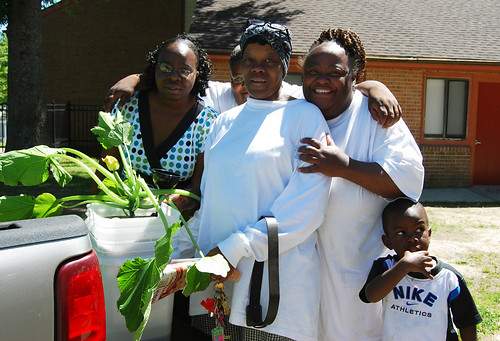 Over the last couple weeks, we have delivered more than 125 container gardens to folks around the Williamsburg area. Everyone seemed excited to receive their gardens. So many people told us that they love gardening, but just didn't have the space or weren't allowed to garden where they're living. The container gardens are a great solution for these folks.
Over the last couple weeks, we have delivered more than 125 container gardens to folks around the Williamsburg area. Everyone seemed excited to receive their gardens. So many people told us that they love gardening, but just didn't have the space or weren't allowed to garden where they're living. The container gardens are a great solution for these folks.

